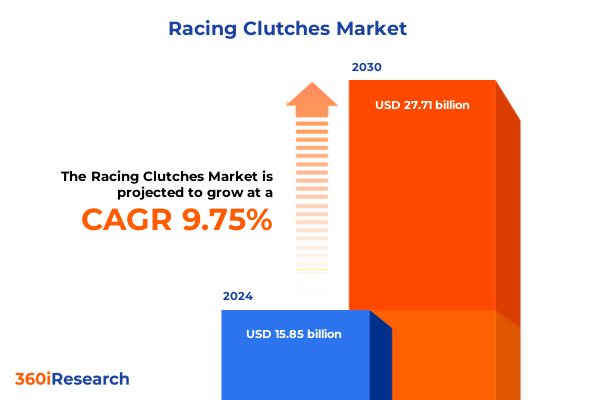The Racing Clutches Market size was estimated at USD 15.85 billion in 2024 and expected to reach USD 17.47 billion in 2025, at a CAGR 9.75% to reach USD 27.71 billion by 2030.

Introduction to the Racing Clutches Landscape
The racing clutch sector stands at the forefront of performance-driven automotive innovation, where precision engineering meets extreme operating conditions. Enthusiasts and professional racers demand seamless power transfer, minimal rotational inertia and unwavering durability under intense heat and torque loads. Advances in metallurgy, friction materials and multi-plate designs have catalyzed a new era of clutch solutions tailored to high-revving engines and rapid gear changes. As vehicle architectures evolve to incorporate hybrid and electric powertrains, the role of advanced clutches in energy recuperation and torque management has grown more critical, inspiring cross-industry collaborations among motorsport teams, OEMs and aftermarket specialists. However, this dynamic environment also presents challenges around material sourcing, thermal management and regulatory compliance in different regions. Balancing performance gains with cost efficiency and sustainability goals requires a holistic understanding of emerging technologies and supply chain dynamics. This introduction sets the stage for a detailed examination of shifting market forces, tariff implications, segmentation nuances and strategic insights that will empower decision-makers to navigate the complexities of the high-performance clutch landscape.
Transformative Shifts in the Racing Clutch Landscape
Recent years have witnessed transformative shifts in clutch design, materials and applications that are reshaping the competitive terrain. Traditional single-plate clutches have yielded ground to multi-plate configurations featuring carbon and ceramic friction surfaces capable of withstanding extreme temperatures and offering rapid engagement. At the same time, additive manufacturing techniques have enabled complex, lightweight housing geometries and rapid prototyping cycles. The integration of smart sensors and actuation systems has opened pathways toward electronic clutch control, enhancing driver feedback and enabling adaptive torque distribution. Regulatory pressures aimed at reducing emissions and improving fuel economy have accelerated the adoption of low-inertia clutch assemblies in both motorsport and limited-production high-performance road cars. Furthermore, the increasing prominence of electric and hybrid powertrains has spurred demand for specialized clutches that facilitate seamless power transitions and energy recuperation. These technological leaps have created new opportunities for partnerships between OEMs, component specialists and aftermarket innovators, driving a wave of mergers, strategic investments and cross-industry R&D programs designed to maintain a competitive edge.
Cumulative Impact of United States Tariffs 2025
The imposition of United States tariffs scheduled for 2025 will reverberate across the racing clutch supply chain, with significant implications for manufacturers, distributors and end users. Higher duties on imported raw materials-particularly advanced ceramics, high-grade carbon composites and specialty alloys-will elevate production costs and potentially restrict sourcing options. Clutch makers that rely on global supply networks must reassess supplier contracts, explore nearshoring opportunities and negotiate volume-based pricing to mitigate added expense. Distributors may adjust pricing structures or seek alternative friction materials with comparable performance yet lower tariff exposure. Meanwhile, OEMs will face pressure to localize high-performance clutch assembly or invest in tariff engineering through redesigns that use domestically sourced inputs. End users could experience increased aftermarket prices for carbon multi-plate assemblies and premium friction discs. However, these tariff-driven cost challenges may also accelerate innovation in material substitution and foster strategic alliances between domestic producers and equipment manufacturers. Staying ahead of the tariff curve will require proactive supply chain analysis, robust cost modeling and agile product roadmaps.
Key Segmentation Insights
A nuanced breakdown of racing clutch demand emerges when viewed through distinct segmentation lenses. Based on product type, the market divides into multi-plate clutches-with carbon multi-plate and ceramic multi-plate variants-and single-plate clutches, which further branch into ceramic single-plate and organic single-plate options. Examining disc material reveals demand tiers for carbon materials, ceramic materials-subdivided into copper ceramic and kevlar-composite-and organic materials, split between fibrous materials and non-asbestos formulations. Vehicle type segmentation highlights commercial vehicles, including heavy trucks and medium-duty trucks, alongside off-road vehicles such as ATVs and UTVs, and a diverse passenger vehicle category spanning coupes, sedans and sports cars. In terms of end users, the aftermarket comprises distributors serving auto parts retailers and performance shops, while OEMs encompass automobile manufacturers and producers of heavy machinery. Sales channel dynamics differentiate offline outlets like specialty stores and wholesalers from online platforms, including B2B portals and e-commerce sites. Torque capacity segmentation stratifies products into high torque above 500 Nm, medium torque of 250–500 Nm and low torque below 250 Nm. Friction material divides into copper-based, semi-metallic and non-metallic, with the latter including ceramic-non-metallic composites. Price range categories encompass economy, mid-range and premium, with premium offerings targeting the luxury high-end segment. Finally, temperature resistance splits into standard grades up to 300 °C and high-temperature variants rated from 300 °C to above 600 °C.
This comprehensive research report categorizes the Racing Clutches market into clearly defined segments, providing a detailed analysis of emerging trends and precise revenue forecasts to support strategic decision-making.
- Product Type
- Disc Material
- Vehicle Type
- End-User
- Sales Channel
- Torque Capacity
- Friction Material
- Price Range
- Temperature Resistance
Key Regional Insights
Regional dynamics exert a profound influence on both demand patterns and supply chain strategies. In the Americas, a well-established motorsport ecosystem and robust aftermarket community drive demand for carbon multi-plate systems and premium ceramic single-plate clutches, while domestic tariff policies encourage localized manufacturing of high-performance components. Europe, Middle East & Africa (EMEA) benefits from a blend of historic racing heritage and stringent emissions regulations, catalyzing the adoption of lightweight clutch assemblies and advanced friction compounds; partnerships between European OEMs and regional aftermarket specialists bolster innovation. In the Asia-Pacific region, rapid growth in motorsport participation and expanding passenger vehicle ownership are fueling demand for mid-range and economy clutch solutions, even as local manufacturers invest in advanced materials research to capture share against established global suppliers. Cross-border trade agreements, regional content requirements and evolving performance standards further shape regional supply networks and product roadmaps.
This comprehensive research report examines key regions that drive the evolution of the Racing Clutches market, offering deep insights into regional trends, growth factors, and industry developments that are influencing market performance.
- Americas
- Asia-Pacific
- Europe, Middle East & Africa
Key Companies Insights
Global competition in high-performance clutches is intense, with several leading players driving innovation and market expansion. Ace Manufacturing and Parts Co. has leveraged advanced forging techniques to produce ultra-lightweight clutch housings, while Advanced Clutch Technology Inc. focuses on electrically actuated clutch modules for hybrid applications. Australian Clutch Services Pty. Ltd. dominates the Southern Hemisphere aftermarket with ceramic single-plate solutions, and Black Magic Clutchee's carbon composite offerings enjoy a niche following among professional racers. Brembo S.p.A. remains a global benchmark for carbon multi-plate assemblies, and C U Custom Clutch Corp. excels in bespoke torque capacity tuning. Clutch Masters Industries Inc. and Competition Clutch Inc. compete aggressively in the performance shop segment, whereas EXEDY Corp. and Helix Autosport Ltd. drive OEM partnerships and integration of sensor-enabled clutch control. Holley Performance Products, Inc. and Klaus Reinicke GmbH have built strong reputations in high-temperature friction materials, while OS Giken USA continues to refine clutch actuation precision. Schaeffler Automotive Aftermarket GmbH & Co. KG and SPEC Clutch, Inc. round out the competitive field with extensive distribution networks and comprehensive product portfolios.
This comprehensive research report delivers an in-depth overview of the principal market players in the Racing Clutches market, evaluating their market share, strategic initiatives, and competitive positioning to illuminate the factors shaping the competitive landscape.
- Ace Manufacturing and Parts Co.
- Advanced Clutch Technology Inc.
- Australian Clutch Services Pty. Ltd.
- Black Magic Clutche
- Brembo S.p.A.
- C U Custom Clutch Corp.
- Clutch Masters Industries Inc.
- Competition Clutch Inc.
- EXEDY Corp.
- Helix Autosport Ltd.
- Holley Performance Products, Inc.
- Klaus Reinicke GmbH
- OS Giken USA
- Schaeffler Automotive Aftermarket GmbH & Co. KG
- SPEC Clutch, Inc.
Actionable Recommendations for Industry Leaders
Industry leaders should adopt a multi-pronged strategy to capitalize on evolving opportunities and address emerging risks. First, prioritize partnerships with material science innovators and invest in joint R&D initiatives to develop next-generation friction compounds capable of enduring extreme temperatures while reducing mass. Second, evaluate nearshoring and dual-sourcing arrangements to mitigate the impact of tariffs and supply chain disruptions; diversify supplier networks to include regional specialty metal and composite producers. Third, integrate sensor-based actuation and electronic control modules into clutch assemblies, thereby enhancing performance tuning, predictive maintenance and drivetrain synchronization. Fourth, pursue strategic alliances with OEMs and aftermarket distribution channels to secure long-term contracts and co-develop region-specific product variants. Fifth, establish a robust digital presence across B2B portals and e-commerce platforms to capture growth in online sales, while maintaining a selective brick-and-mortar footprint for high-touch performance shop relationships. Finally, implement agile product roadmaps that balance premium, mid-range and economy offerings, ensuring resilience across shifting macroeconomic cycles and customer budgets.
Explore AI-driven insights for the Racing Clutches market with ResearchAI on our online platform, providing deeper, data-backed market analysis.
Ask ResearchAI anything
World's First Innovative Al for Market Research
Conclusion
As the racing clutch arena accelerates toward greater complexity and performance demands, stakeholders must remain vigilant in tracking technological advances, regulatory shifts and shifting customer expectations. Success will hinge on the ability to harmonize material innovation, supply chain agility and digital engagement strategies. By refining segmentation-driven product portfolios, targeting region-specific growth pockets and forging strategic partnerships, manufacturers and distributors can navigate tariff headwinds and capitalize on new opportunities in hybrid and electric propulsion. Furthermore, leveraging data-driven insights from embedded clutch sensors will unlock predictive maintenance models and continuous performance optimization. As the competitive landscape intensifies, agility and collaboration will define market leaders, enabling rapid adaptation to evolving performance standards and sustainability imperatives. Ultimately, those who integrate advanced friction materials with electronic control, maintain diversified sourcing strategies and foster deep ties with OEMs and aftermarket channels will unlock enduring growth and brand differentiation.
This section provides a structured overview of the report, outlining key chapters and topics covered for easy reference in our Racing Clutches market comprehensive research report.
- Preface
- Research Methodology
- Executive Summary
- Market Overview
- Market Dynamics
- Market Insights
- Cumulative Impact of United States Tariffs 2025
- Racing Clutches Market, by Product Type
- Racing Clutches Market, by Disc Material
- Racing Clutches Market, by Vehicle Type
- Racing Clutches Market, by End-User
- Racing Clutches Market, by Sales Channel
- Racing Clutches Market, by Torque Capacity
- Racing Clutches Market, by Friction Material
- Racing Clutches Market, by Price Range
- Racing Clutches Market, by Temperature Resistance
- Americas Racing Clutches Market
- Asia-Pacific Racing Clutches Market
- Europe, Middle East & Africa Racing Clutches Market
- Competitive Landscape
- ResearchAI
- ResearchStatistics
- ResearchContacts
- ResearchArticles
- Appendix
- List of Figures [Total: 34]
- List of Tables [Total: 1199 ]
Call to Action: Connect with Ketan Rohom for the Full Racing Clutches Report
To secure your competitive advantage in this high-stakes market, reach out to Ketan Rohom, Associate Director, Sales & Marketing, to obtain the full comprehensive market research report. This resource provides unparalleled insights on tariff impacts, segmentation nuances, regional trends and company strategies that are essential for informed decision-making. Engage today to access detailed competitive intelligence, actionable recommendations and data-driven analysis that will empower your organization to lead in the racing clutch domain.

- How big is the Racing Clutches Market?
- What is the Racing Clutches Market growth?
- When do I get the report?
- In what format does this report get delivered to me?
- How long has 360iResearch been around?
- What if I have a question about your reports?
- Can I share this report with my team?
- Can I use your research in my presentation?




